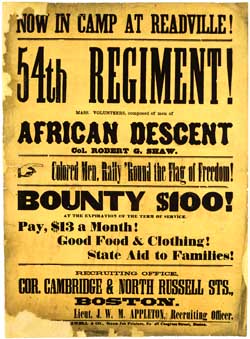The Civil War was not a war of justice and equality or a war that was meant to liberate the slaves, but when the war was not going as planned, the liberation of slaves became the most important movement of the war.
“Prior to 1863, no concerted effort was made to recruit black troops as Union soldiers.”
Yet when the Emancipation Proclamation was adopted, the recruitment of black men to form black troops for the union began.
The 54th recruitment formed by Massachusetts “was the first to respond” in the creation of black troops. 
Even as Massachusetts recruited men, as displayed in the poster displayed below, the number of men needed was not enough.
In order to increase the numbers of men in the troops, recruitment went further than cities and states. In order to increase the number of men, recruiters went North, South and even to Canada.
 Even as these troops were black men only, they were lead and trained by white men.
Even as these troops were black men only, they were lead and trained by white men.
Even as the war shifted change, the race tensions existed.
People still believed that black men (men in this case, due to only men being allowed to join the army) were children and, therefore, had to be taken care of.
This ideology can be compared to the white man’s burden; in which the whites believe that the they had to help people of color better themselves.
The change and decision to use black men to fight the civil war may have seen as a cultural revolution and maybe even as a step to equality, but the amount of continuous discrimination showed that equality was nowhere to be seen.
Even if equality was not reached with the “freeing” of slaves or the creation of black troops, the creation of the 54th Regiment was a milestone that years before would have been thought as a wild dream and nightmare.
WORKS CITIED:
Jennifer,
I’m so glad you covered the 54th Massachusetts Regiment in your post since we didn’t extensively discuss it in lecture nor discussion. The secondary source hyperlink was informative, yet make sure to actually incorporate the source into your final blog post in order to have it support your analysis (whether historical or artistic). Besides that, your post was clear and to the point. Splendid job!
LikeLike
Hi Jenny! Just some suggestions: I think you should include more analysis and more historical context. You could always add the information presented in the lectures! You could add more pictures and links if applicable. Overall, I think it is a very interesting topic! :DDD Keep up the good work!
LikeLike